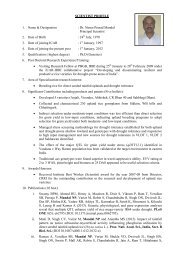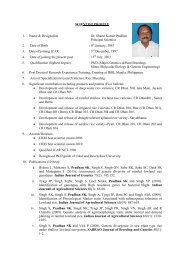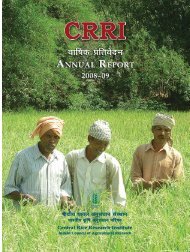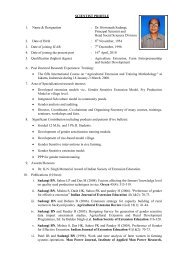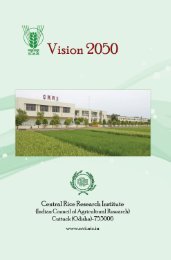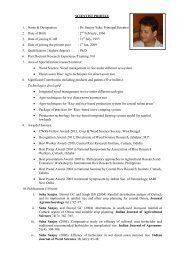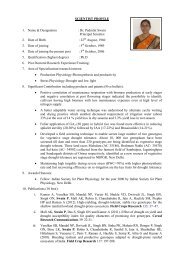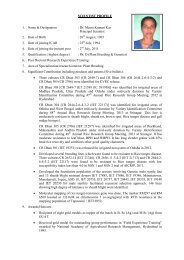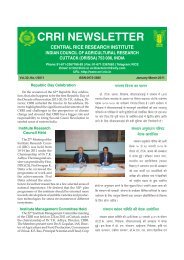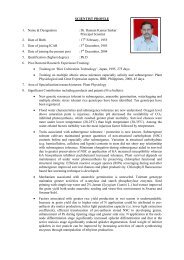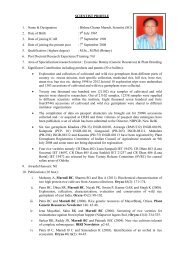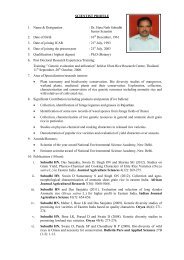Central Rice Research Institute Annual report...2011-12
Central Rice Research Institute Annual report...2011-12
Central Rice Research Institute Annual report...2011-12
Create successful ePaper yourself
Turn your PDF publications into a flip-book with our unique Google optimized e-Paper software.
(CR42668, CR3005-77-2, CR3005-230-5, CR3005-11-3,<br />
CR3005-226-7 and CR3006-8-2) resistant to BPH with<br />
(SES) score 1, two genotypes (CRAC43019 and CR43020<br />
) resistant to rice rootknot nematode with 0.7 and 0.3<br />
gall index and four genotypes (CR3005-230-5, CR2711-<br />
76, CR3005-77-2 and CR3006-8-2) highly resistant to<br />
planthoppers.<br />
Two cultivars (IR84649-260-28-1-B and IR84649-21-<br />
15-1-B) were identified to have higher level of submergence<br />
tolerance irrespective of salinity of the flood water.<br />
Under rainfed upland situation, even with exposure<br />
to drought stress at both vegetative and reproductive<br />
stages conditions, RR383-2, RR2-6, CR143-2-2, Zhu<br />
11-16, RR443-2, IET21620, IET22026, IET22032,<br />
Kalakeri and Sahabhagidhan had yield potential of<br />
more than 1.50 t ha -1 with more than 50% grain filling.<br />
The hybrid Ajay grown under aerobic and AWD conditions,<br />
gave a stable yield of 5.30 t ha -1 indicating its<br />
adaptation to water limited conditions. Eight improved<br />
breeding lines with new plant type characters have been<br />
developed.<br />
Fifty six cultivars (nine aromatic varieties and 47<br />
landraces) were characterized through DNA finger<br />
printing using SSR and ISSR markers. Twenty six CRRI<br />
released varieties for lowland situations were also characterized<br />
using SSR for assessing the genetic relatedness<br />
among them. Four promising aromatic short grain<br />
cultures viz., CR2713-11, CR2713-179, CR2947-18 and<br />
CR2713-180 were promoted to next year of testing under<br />
AICRIP. Two high protein rice cultivars viz.,<br />
ARC10063 (16.41%) and ARC10075 (15.27%) were<br />
found to have higher activities of glutamine synthetase<br />
(GS) and glutamate oxo-glutarate aminotransferase<br />
(GOGAT) at the maximum tillering stage.<br />
Balanced application of nutrients plays a major role<br />
in maintaining the soil quality. In a long term (41 years)<br />
rice-rice system under different nutrient management,<br />
when compared with NPK treatment, soil quality declined<br />
by 47.3, 35.8, 5.7 and 14.0% in control, N, NP<br />
and NK applied plots, respectively.<br />
Nitrogen and zinc management plays important role<br />
in aerobic rice, it is found that leaf colour chart (LCC)<br />
based recommendation resulted higher agronomic N<br />
use efficiency (17-18%) and N recovery efficiency (26-<br />
30 %) over the recommended dose of fertilizer (RDF).<br />
The water soluble plus exchangeable zinc, organically<br />
bound zinc and crystalline sesquioxide bound zinc<br />
were higher under aerobic moisture regimes while the<br />
submergence helped to increase the manganese oxide<br />
bound zinc, amorphous sesquioxide bound zinc and<br />
residual zinc.<br />
The differential response on individual rice genotypes<br />
to P deficiency is based on the type and quantity<br />
of organic acids exuded, thus suggested a genotype and<br />
nutrient-specific regulation of biosynthesis and release<br />
of root exudates.<br />
The standardized precipitation index (SPI) based<br />
drought map of Odisha, prepared based on 26 years of<br />
rainfall data using Spatial Analyst tool of Arc GIS,<br />
showed the seasonal pattern of meteorological drought<br />
at three months time scale; this will be useful in developing<br />
mitigation strategies of the drought events in the<br />
region.<br />
The SRI method of rice cultivation (<strong>12</strong> days old seedling,<br />
25 cm x 25 cm spacing, organic source of nutrients<br />
through application of FYM @ 5.0 t ha -1 and weeding<br />
by using conoweeder) was compared with the practices<br />
in which various nutrient and weed management<br />
practices were taken separately, keeping the seedling<br />
age and spacing of SRI method unchanged. It was<br />
found that application of chemical fertilizer @ <strong>12</strong>0%<br />
RFD significantly enhanced the yield over that applied<br />
with organic manure. Similarly the herbicide<br />
Azimsulfuron @ 35 g a.i. ha -1 (low dose high efficacy<br />
and safe) were found to be effective and produced at<br />
par yield with that of conoweeder.<br />
In wet direct seeded, tank-mix application of<br />
bensulfuron methyl + pretilachlor (applied as postemergent<br />
18 DAS at 50 + 450 g a.i. ha -1 ) was found to be<br />
most effective for controlling the predominant weeds<br />
[weed control efficiency (WCE) 91%] and produced comparable<br />
yield (5.67 t ha -1 ) with hand weeding twice (5.77<br />
t ha -1 ).<br />
Three rice based cropping systems such as rice–potato–sesame,<br />
rice–maize–cowpea and rice – groundnut–green<br />
gram were evaluated, it was found that highest<br />
production efficiency (REY 14.9 t ha -1 ) and lowland<br />
utilization efficiency was observed in rice-potatosesame<br />
cropping system although rice-maize-cowpea<br />
was found to be the most economical system.<br />
The rice-fish-horticultural crops-agro forestry based<br />
integrated farming system model developed at Cuttack<br />
for deepwater ecology generated a net income of Rs.1<br />
lakh ha -1 , similarly integrated rice-fish farming system<br />
developed for flood prone areas at Gerua generated<br />
gross income of Rs.1.63 lakhs ha -1 .<br />
One hundred and thirty seven agriculturally important<br />
microbes were identified including nine<br />
chlorpyrifos degrading bacteria, 17 B. thuringiensis and<br />
59 Pseudomonas strains isolates produced siderophore,<br />
HCN and salicylic acid, effective against insect pests<br />
and plant pathogens. Four potent native<br />
entomopathogenic Bt against leaf folder were formulated<br />
for mass field application.<br />
<strong>12</strong><br />
CRRI ANNUAL REPORT 2011-<strong>12</strong>



